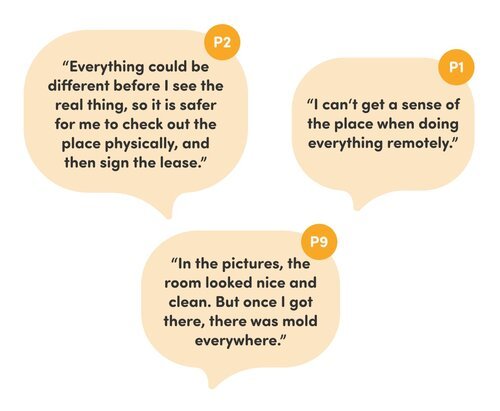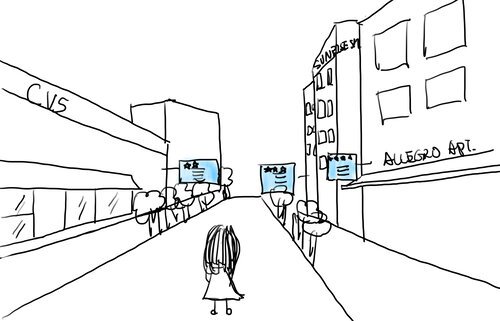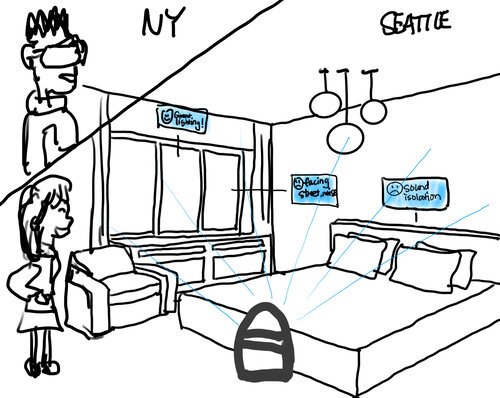Vtour Design Process
Research
After analyzing 10 existing solutions, we uncovered a clear gap: renters lacked reliable, in-depth insights when touring remotely. This validated our vision for a more tailored and trustworthy virtual touring experience
Competitive Analysis
Competitive Analysis Products
We ran a remote card sorting activity with 6 participants using Miro to uncover what matters most to renters. Cleanliness and noise levels rose to the top, critical factors that are notoriously hard to gauge without an in-person visit.
Card Sorting Activity
Screenshot of one of the participants card sorting activity.
We gave 6 participants house-hunting scenarios to map how they make decisions. A common theme emerged: renters struggled to get a sense of the home’s overall 'feel,' leading to hesitation and uncertainty when touring remotely.
Observation Analysis
Screenshot of observation analysis with one of our participants using Zillow.
We interviewed 12 participants for 45 minutes each to dive into their remote house-hunting experiences. Many leaned on trusted friends or family to visit properties in person, seeking reassurance and confidence before committing to a home.
Semi-Structured Interviews
Quotes from 3 of our participants.
Through thematic coding and virtual sticky notes, a key insight emerged: renters don’t trust online listings alone. They want human confirmation for critical details before making a decision.
Synthesis
Define
Scope
After synthesizing our research, we identified four key stages in the house-hunting journey: Research, Tour, Compare, and Select. The Tour stage posed the biggest challenges, especially for remote renters. We narrowed our focus to designing solutions that help renters get a true sense of the home from afar, building trust and confidence in their decisions.
After multiple iterations, we refined our research question to align with our scope, focusing on how to help renters build trust in the remote house-hunting process.
How Might We
“How might we enhance the house-hunting experience and help renters trust the process remotely?”
Transparent
Renters receive accurate, trustworthy information through an open and honest process.
Customized
Solutions are tailored to match each renter’s unique needs and preferences for their future home.
Comprehensive
The design considers all relevant factors, helping renters make informed, confident decisions.
Guided
The experience is streamlined and intuitive, supporting users from start to finish through every step of the journey.
Design Principles
Ideate
During ideation, each team member generated 20 concepts. After discussing feasibility, effort, and timeline constraints, we narrowed the list down to 3 strong ideas.
3 Concept Ideas
1. Virtual Meeting Game
A virtual game where renters explore neighborhoods as avatars and connect with locals, building trust through firsthand, immersive insights.
2. VR/AI Showroom
A VR showroom where renters explore 3D models of listings. AI then generates a home performance report based on their onboarding preferences.
3. Guided Tour Platform
A platform that connects renters with trusted contacts near the property to tour on their behalf, guided by a customizable checklist based on renter preferences.
We realized the first two concepts didn’t fully address the core challenge, helping renters get a true feel for the home. After weighing feasibility, viability, and desirability, we moved forward with our guided tour solution.
Next, we focused on identifying key features that would best support renters while aligning with our design principles. To bring the vision to life, we created an initial concept storyboard to illustrate the experience.
Storyboard
After choosing our concept, we ran a virtual Figma workshop with 5 potential users to explore how they might feel about trusting a stranger to tour a home on their behalf. Each participant received a unique personality scenario to help us understand varied responses.
Key Insights
Renters value knowing how long a viewer has lived in the area, it signals credibility. We’ll include this info on viewer profiles.
Profile verification and ratings from people who know the viewer can boost renter confidence and foster trust.
Renters are more likely to trust viewers who share similar lifestyles or housing values.
Viewers should handle scheduling to reduce friction for renters and create a smoother experience.
Renters want to engage with the viewer during the tour, asking questions and guiding the experience in real time.
Concept Development Workshop
Screenshot from workshop done using Figma
Sketches
We began mapping key user flows while building low-fidelity wireframes to bring the experience to life. Using these wireframes, we conducted usability testing on specific flows and uncovered the following insights:
Wireframes/User Flows
Onboarding Experience
We designed a matchmaking questionnaire to help renters find viewers they’re most likely to trust. Each question was carefully crafted to align renters with viewers who share their values, priorities, and expectations, ensuring a more personalized and reliable touring experience.
Insights from Usability Testing
The combined onboarding and matchmaking flow felt too long and didn’t clearly communicate the app’s core purpose.
Users preferred matchmaking to be optional so they could first explore potential viewers.
Some questions felt unnecessary or irrelevant depending on the user, leading to frustration.
Inconsistent interaction patterns across different questions disrupted the overall experience.
Finding a Viewer to Schedule a Virtual Tour
This feature lets renters search for viewers near their desired home to schedule a virtual tour. We integrated a map to make it easy to find someone local and available—bringing more trust and convenience to the process.
Insights from Usability Testing
Viewers’ map location wasn’t valuable, users prioritized viewer quality over proximity.
The tour scheduling flow was unclear and caused confusion.
Users preferred to request a preferred time frame rather than selecting a fixed slot.
Creating an Inspection
We designed a guided inspection feature where viewers can add notes during the tour. It’s customizable based on the renter’s priorities, ensuring transparency and keeping renters actively involved in the process.
Insights from Usability Testing
Linking listing accounts is better suited as part of the onboarding flow.
The meaning of “pending” is unclear and needs clarification for users.
Prototype
Iterations
Changes to Matchmaking Questions
Initially, we focused our questions on specific renter priorities, asking users to select key factors and answer follow-up questions for each. However, the survey felt too long and overwhelming. To simplify the experience, we shifted to broader lifestyle questions to help match renters with viewers who share similar values and needs.
Initial Iteration
Final Iteration
User Flow Simplifying
Our initial idea featured a step-by-step tour creation process directly on the homepage. However, users felt overwhelmed by the number of steps. To simplify, we introduced a 3-step Wizard of Oz at the top of the page, doubling as a navigation bar for a clearer, more manageable flow.
We went through three rounds of iterations, conducting usability testing between each to gather feedback and refine the experience based on user insights.
Initial Iteration
Final Iteration




















